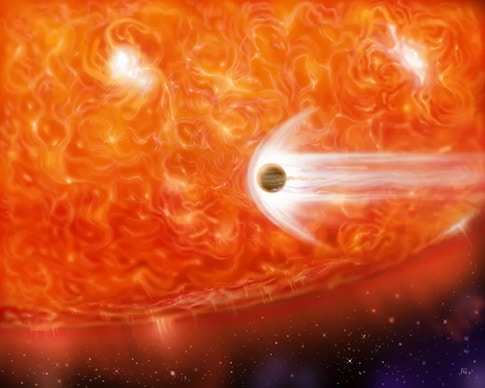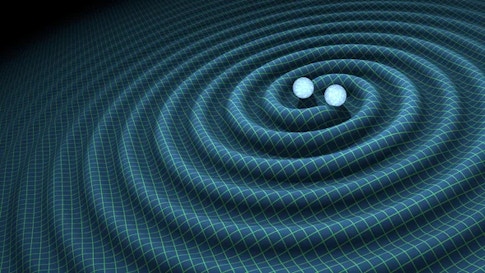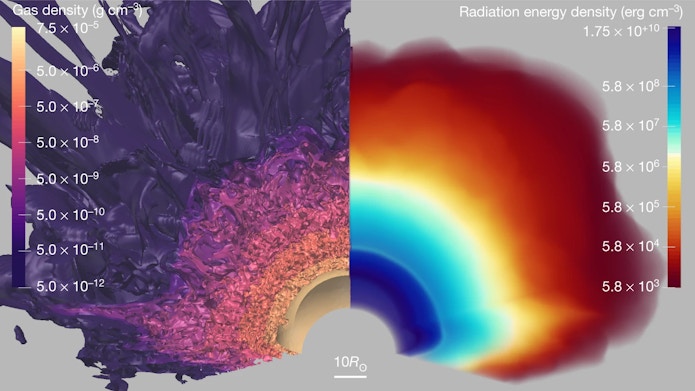The Secret Lives of Stars

The stars in the night sky might look unchanging, but they lead complex and exciting lives. At the Flatiron Institute, theoretical astrophysicist Matteo Cantiello spends his days figuring out how massive stars change over their life cycles and how these changes affect the evolution of galaxies. To do so, he creates computer models that can be compared with observational data to help astronomers understand how these stars live and die.
Cantiello is a research scientist at the Flatiron Institute’s Center for Computational Astrophysics and a visiting associate researcher at Princeton University. Prior to that, he worked at the Kavli Institute for Theoretical Physics at the University of California, Santa Barbara and was an Argelander fellow at the University of Bonn. He received his doctorate in theoretical astrophysics from Utrecht University and his master’s in theoretical physics from the University of Pisa.
Cantiello recently spoke to the Simons Foundation about his work and the humbling scales of the universe. The conversation has been edited for clarity.
What is your current research focus?
Right now, I’m working on three main problems.
One is how expanding stars eat planets. When a star gets to the end of its life, it runs out of hydrogen in its core, which causes the star to expand. For a star like our sun, that expansion will consume the planets out to Mars. Small planets probably wouldn’t affect the star much, but in other planetary systems, Jupiter-sized planets could be ingested, which could impact the luminosity and chemistry of the star. In that case, the question we’re particularly interested in understanding is: What happens to the planet and what happens to the star? We’re investigating this numerically by running computer models that can help us see what might happen to the planet and star and what signs that might leave that we could potentially observe.

Second, I’ve been interested in understanding the observational fact that some massive stars seem to be ‘noisy.’ If you look at the light coming from these stars, over time their brightness changes in a very irregular way. If you chart this change over time, it looks ‘noisy.’ There’s speculation on what might cause this, so we’re modeling these stars to figure out what is happening. It’s some kind of perturbation coming from deep within the star, or closer to the stellar surface. The jury is still out but I think our group is pretty close to figuring it out.
Another problem that I am working on is a situation that can happen with galaxies that have an active supermassive black hole at their center. When material, such as dust or gas, falls into such a black hole, it can create what is called an accretion disk — a structure formed by diffuse material as it slowly falls into the black hole. What I’m interested in is what happens if a star ends up in this disk. There is some compelling evidence that this situation might be common because the density of stars in galactic centers is very high, so it’s likely some could be captured by these accretion disks.

Unlike normal stars, these entrapped stars are now stuck in this hot bath of gas, which they can start sucking up thanks to their gravity. If there’s enough material, these stars can grow many hundreds of times in mass. I’m interested in figuring out how this happens, and what impact that has on the system and the galaxy.
How do you model a star? What tools do you need?
Stars are complicated beasts. They have a lot of physics, they’re big, and they live for a long time. This makes it impossible to run full, 3D simulations of stars over their whole lives, at least with our current technological capabilities. So we have to simplify the problem.
One way is using 1D models to get a simplified understanding of what the star looks like at the surface throughout its life. These models are relatively cheap, so we can run them and calculate the full lifetime of stars. By comparing observations of a star to this type of model, we can find shortcomings in our understanding. This can then be augmented with snapshots of 3D models in the places where the 1D model doesn’t make sense or doesn’t match observations. Taken together, this approach helps us build a more complete picture of what’s happening and figure out if we’re missing physics or some piece of the puzzle.
How does learning about stars help us understand the universe and our place in it?
Massive stars play a prime role in many phenomena in astrophysics. They create explosive events, like long gamma ray bursts and supernovae, and leave behind compact remnants, like neutron stars and stellar-mass black holes. These stars also eject tons of energy and material into a galaxy upon their death, so they affect the chemical and dynamical evolution of galaxies as well. Massive stars also forge the carbon, nitrogen and oxygen that make up your DNA. If you want to understand the elements you’re made of, you must understand the life cycles of these stars.

Stars of lower mass can also be used to measure the vast distances in the universe to help explain why the expansion of the universe is accelerating, which is one of the biggest mysteries in cosmology. And since they host exoplanets, these stars can also help us understand what is needed to have a habitable planet and the possibility of life in the universe.
Astronomy is a discipline that really helps you realize the scale of things in the universe. It has this ability to put things in perspective. I think when you start understanding these concepts in astronomy and how empty space is, the scale of humanity really gets to you. It’s really humbling.
This Q&A is part of Flatiron Scientist Spotlight, a series in which the institute’s early-career researchers share their latest work and contributions to their respective fields.